

During the fall of 2022 an email arrived in my inbox stating that our longtime friend Dave Mehlman had been named “tour guide of the year” for Naturalist Journeys, a small company that specializes in nature tours around the world. “Hmmm,” I said to Mark, “I wonder what other tours Dave is leading?” Iceland in June 2023 was one of Dave’s upcoming trips. In the past Dave had taken his friends, including us, to Ecuador, Guatemala and Peru, but we had never been on a tour with strangers.
 I emailed the Iceland trip link to Susan, my best friend of 50 years, and Paul, her husband, in Tallahassee and said, “Iceland, anyone?” A few days later Susan replied, “We’re in!” Susan, Paul, Mark and I had planned our own trip to Belize in 2013. Then Susan and I celebrated our 60th birthdays with a group that went to Costa Rica. Now we looked forward to a new adventure.
I emailed the Iceland trip link to Susan, my best friend of 50 years, and Paul, her husband, in Tallahassee and said, “Iceland, anyone?” A few days later Susan replied, “We’re in!” Susan, Paul, Mark and I had planned our own trip to Belize in 2013. Then Susan and I celebrated our 60th birthdays with a group that went to Costa Rica. Now we looked forward to a new adventure.


Next I sent the Iceland link to John Stewart, Mark’s friend of 60 years who lives in London, England. John’s wife Meg could not go, but John wanted to. I had hoped to fill the entire 10-person tour with our friends, but I wrote Naturalist Journeys and asked if I could proceed with recruiting more travelers. They wrote back, “Merri, please stop, we’re now full.” Oh, well, at least we created a buffer of our besties for the tour.
During the next six months, we bought airline tickets (Icelandair flies nonstop to Keflavik, Iceland from Denver, Seattle, JFK, Chicago and other cities), planned a few extra days ahead of the tour, did research, watched videos about Iceland, and bought some recommended items of clothing. Mark and John decided to stay four days after the tour ended, rent a Jeep and head east toward waterfalls, glaciers, rivers and parks that we would not visit on our tour. Mark reserved two nights at 1×6 Guesthouse in Keflavik, which they loved, and two nights at Holiday Houses near Vik, which they did not love. Mark, Dave, and I planned two nights in Reykjavik at the Hotel Reykjavik Centrum, which was a delightful small hotel close to birding areas, museums, restaurants, pubs, and the harbor.
Mark and I left our little dog with our trusty housesitter Brie and headed to Denver on June 10. We had a four-hour layover, then an eight-hour nonstop flight from Denver to Reykjavik. In the airport, we kept seeing a guy walk by. I said to Mark, “That looks like Gary King (son of our former NM Governor and former Attorney General himself). What are the odds?” Naaaa, it couldn’t be. We boarded the plane and seated behind us were the guy and his wife. “Excuse me,” Mark said, “are you Gary King?” “Why, yes, I am…” What are the odds?! Pretty good, I guess. Such a typical small world New Mexico story. I greeted Gary and Yolanda (we knew each other from campaign trails long ago and Gary was our friend Mary Smith’s boss for years), texted Mary a photo, then settled in for an eight-hour flight.

We arrived at 6am Reykjavik time, midnight our time. Dave’s flight arrived an hour later, so we entered the country, claimed our luggage, withdrew some Krona, the unique currency of Iceland, (we needn’t have done that; American dollars, Visa and Mastercard are widely accepted in Iceland) from the ATM and settled in to wait for Dave. Dave got to us about 7:30am and we boarded our Flybus to the BSI Terminal, a 40-minute ride. There we caught a local shuttle for a short trip to City Hall, Bus Stop 1, about a block from Hotel Reykjavik Centrum, our home for the next two nights. The hotel staff was awesome and let us check in early for a $35 fee. We didn’t want to sleep until that night, so we deposited our luggage in our rooms and met in the lobby to take a walk.
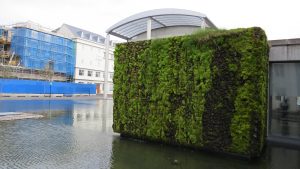
A block away was Tjörnin, a series of three or four ponds with lots of waterfowl and songbirds in the nearby copse. During the first hour, we saw eight life birds (never before seen by us), so we were happy. Unlike Central and South America, which host thousands of bird species, Iceland has only 90 or so regular bird species. Our Iceland Ebird Trip Report contains 78 species, 58 of which were lifers for me. Click on the link to view species with our photos.
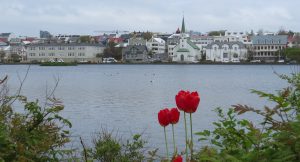
Reykjavik is beautiful and very walkable. We walked everywhere–to morning coffee, to various restaurants, to the harbor, to museums, to the murals we admired.

I texted our former neighbor Deirdre a photo of this mural and she texted back, “I follow that artist on Instagram!” (Yes! T-Mobile works in Iceland at no additional charge for unlimited data and texts, at least, on our Magenta plan.) And WiFi in Iceland is underground fiber optics. Speeds there were ten times as fast as our plan with CenturyLink. America could learn a thing or two from Icelanders.

We ate lunch at Mandi’s Middle Eastern restaurant, which was delicious. Then Dave and I napped while Mark blogged. Later we walked to the harbor, saw people clad in swishing nylon coveralls going out in small whale-watching boats, watched numerous families of common eiders with their newly hatched chicks, and got fish and chips at a food truck on the wharf. We ate our delectable meal outdoors even though it was a bit chilly. Then we stopped at Slippbarinn, a pub along the harbor. Although it is light 24/7 in Iceland during June, Mark and I had these Soft Sleep Masks. We were in bed by 8:30pm and slept for thirteen hours.
The next morning we had great coffee (cappuccino with a foam bear!) and pastries at IDA Bokakaffi, Vesturgata 2a, Grófin 101, Reykjavík, a charming shop that is also a bookstore.
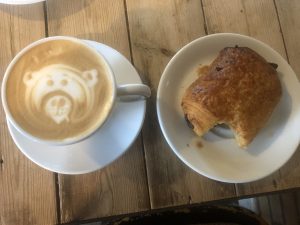
Then I revisited Tjörnin and explored Cemetery Holavallagardur, established in 1838, a block from the hotel. “Remember me as you walk by, for as you are, so once was I. And as I am, so you shall be. Prepare yourself to follow me.” If ever there were a cemetery to do justice to this poem, it’s this one, a mystical, tree-filled, moss-covered eternal sanctuary with many old headstones and lots of flowers. The cemetery also hosted dozens of birds and their newly fledged young, like this redwing:
hotel. “Remember me as you walk by, for as you are, so once was I. And as I am, so you shall be. Prepare yourself to follow me.” If ever there were a cemetery to do justice to this poem, it’s this one, a mystical, tree-filled, moss-covered eternal sanctuary with many old headstones and lots of flowers. The cemetery also hosted dozens of birds and their newly fledged young, like this redwing:

Susan and Paul arrived at the hotel in time for lunch; John was due later that afternoon. All six of us stayed at the Centrum.

We walked to Arctic Street Food for loaves of brown bread hollowed out and filled with lamb stew or seafood stew. A few had Icelandic beer with lunch. A self-described “ginger boy” with red hair and blue eyes served us and was very excited to discover some of us lived in New Mexico. He had lived in Arizona with his family for a while, but returned to Iceland.

We all walked to the Maritime Museum, which Paul and Dave visited. On the way Mark, Dave and I showed our favorite street murals. Then Susan and I went to the Reykjavik Art Museum while Mark went back to Centrum to journal and wait for John. When John arrived, we all walked back to Slippbarinn for dinner and beers. Afterwards we got gelato near the Centrum and toured the cemetery.
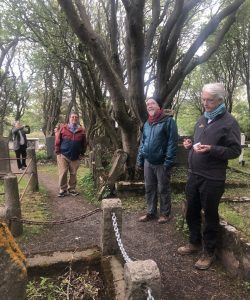
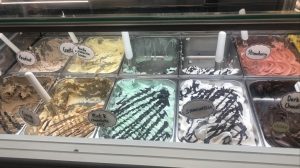
Since Susan and Paul were very tired, we had an early night and reconvened the next day to repeat our coffee/pastry breakfast. We were to meet the rest of our tour group with Daniel Bergmann, our local Icelandic guide and renowned photographer/birder. Someone’s late flight delayed our start, so I took a few folks to Tjörnin.
Candice and Tim from Denver arrived at City Hall, Bus Stop 1, where we were meeting Daniel. On board the van were Daphne from Arizona, Sandy and Tim from Chicago, and Peter and Brenda from Spokane. We headed out of Reykjavik to our first bird stop, Bakkatjörn. Scopes emerged, bird views and “oohs” and “aahs” commenced. We stopped for lunch and landed at Staðarsveit–Ytritunga, complete with shorebirds and harbor seals.
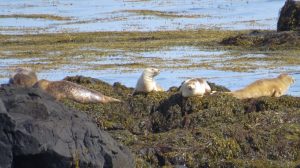
On to Kast Guesthouse located in the quiet countryside of the Snæfellsnes Peninsula. This was home for the next three nights. Our group occupied most of a new wing at one end. Dinner was fish or lamb, soup and vegetarian options. Breakfast was delicious with the best homemade brown seeded bread I’ve ever eaten, a variety of cold cuts, Skyr yogurt, cereal, hard-boiled eggs and other goodies. Plenty of coffee and tea was provided. You can ask for sack lunches.
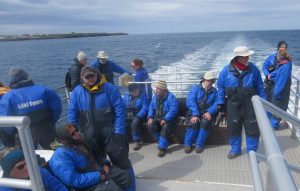


The next morning we loaded ourselves and day gear onto the van for a drive to Ólafsvík for a whale-watching boat trip with Láki Tours. One never knows if one will see any whales, but it was worth the risk. We rode a big boat with lots of other tourists besides our group. We all dressed in polypropylene (or some rubbery material) coveralls, which were bulky but helped keep us warm. Presumably we would have floated a while if the ship had capsized (it did not). Orca, humpback, sperm and minke whales were possible in the sea. We saw our first puffin floating on the waves, northern gannets, various gulls, kittiwakes, and murres.

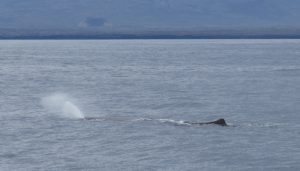
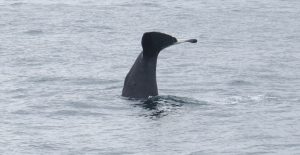
Suddenly the crew spotted the spout of a sperm whale fairly close to our boat. The boat turned sideways and cut its engines. We watched as the whale swam, blew water from its spout, and ultimately dived down into the ocean, its tail flashing farewell. It was so beautiful that I cried and I looked for Susan, who was crying and looking for me. (We also cried when a resplendent quetzal burst from the Monte Verde Cloud Forest in Costa Rica near us.) Sometimes nature’s beauty overwhelms us. We observed three more sperm whales and after about four hours, returned toward the dock. The crew gave a short lecture about different types of whales, their feeding habits, and why we should boycott restaurants that serve whale. Hunting has decimated whale populations.




After lunch we visited Svörtuloft, cliffs filled with nests of northern fulmars, black-legged kittiwakes, common and thick-billed murres (John, I mean “guillemots”!), and razorbills (aka Brünnich’s guillemots to Europeans). We studied the different marks on bills, observed the social structure, then drove through the western region of Snæfellsjökull National Park to return to Kast Guesthouse for dinner. At one point we stopped to watch an Arctic fox wend its way across the mossy rocks on the tundra.

The following day the van departed at 8:30am to tour other parts of the Snæfellsnes Peninsula, including Hraunsfjörður, home to several nesting European golden-plovers. Here my disaster occurred when the van door was shut before I was completely seated, jamming my Canon PowerShot SX50HS camera between the door and my hip.
My camera was unusable early on day three of the tour. While I was in shock, Mark walked up with a Canon PowerShot SX70HS camera belonging to John. John, ever the chivalrous one, said he was too burdened switching among the camera, scope and binocs; that I had helped him choose this camera; that I was the better photographer; and that I should use his camera until I left Iceland. I wept with relief and gratitude. Later our group ate a picnic lunch in a woodland with Icelandic horses grazing nearby.

We then visited Daniel’s hometown of Stykkishólmur, Vesturland, where the Norwegian House had an exhibit of Daniel’s phenomenal photographs. He gave me permission to photograph one of his photos and his accompanying book about gyrfalcons shown in the museum.

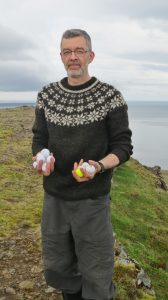
Daniel is mostly quiet, humble and funny as hell, but he is also an amazing photographer, birder and conservationist. Having a local guide on our tour was a real plus. Daniel knows every cliff, every pond, every bush where a bird, rare or otherwise, might be lurking. It’s because of him that we were in the presence of 78 species, not all of which everyone saw. He also brings a library of books about wildflowers, geology, geysers and other Icelandic treasures in case people have questions or want to learn more. He kept us away from the massive busses and tourist sights and showed gems of his country we would not have known about without him.

Later most of us walked up, up, up a hill to the Lighthouse Súgandisey with a vast view of cruise ships, ocean, and cliffs. We searched for a white-tailed eagle, which is so scarce, we cannot share locations or other details. On the way home, Daniel got a report that a rare king eider had been spotted where we had seen the harbor seals. It was just across the lake from Kast Guesthouse, so right on the way home. Daniel spotted it immediately, and Mark and a few others actually got a photo with its head raised rather than tucked into its back. Wow!!!

We stopped at one more pond with a rare common pochard on the way home when Paul, a nonbirder, asked, “Daniel, are you SURE there isn’t another place to stop between here and Kast to look for birds?” The entire vanful of people erupted into laughter. To the Kast Guesthouse we went (without more stops), tired but happy to be home, eat dinner and go to sleep.


We bid “bless” to Kast Guesthouse (but not before I took a walk through the farmland and spotted some European golden-plovers in the mist). We headed out in the rainy fog toward Akureyri in the far north of Iceland, stopping at a cascading waterfall on the way. Candice noticed a crashed drone at the bottom of the cliff below the falls. Sometimes karma IS a bitch. We arrived at the Lamb Inn in Akureyri mid-afternoon. Most of us joined Daniel for a woodsy walk at Kjarnaskógur, a short distance away.
At dinner Johannes, the proprietor/owner of the Lamb Inn, welcomed us at dinner, then left to sing with his choir. He first performed for us a cappella an old folk song in Icelandic. Dinner was delicious and Luna, the main staff person, was a whirlwind–keeping service flowing and problem-solving along the way. Food is locally sourced, and the ice cream was some of the best I’ve ever tasted.

Breakfast was quite the spread; only half of it fit into one photo. The van left at 8:30am to explore the northern coast of Iceland. Daniel searched the cliffs for rare gyrfalcons, the national bird of Iceland. We observed one from afar.

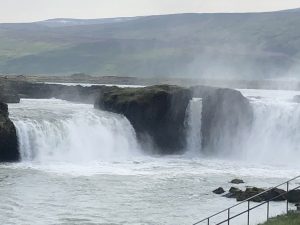
We stopped at Vestmannsvatn, the only known location of an Arctic loon that has returned there for five seasons. Another pond in the Lake Mývatn Kálfaströnd region revealed barrow‘s goldeneyes, Eurasian green-winged teal, whimbrels and other birds. Here’s John, my camera hero, striding between the lakes. We spent a lot of time in this area, ending at Laxá í Mývatnssveit, a rushing creek featuring harlequin ducks at close range, long-tailed ducks, wagtails, and barrow’s goldeneyes.
Eventually we headed back toward the Lamb Inn for dinner, stopping for a short visit to Goðafoss, ‘Waterfall of the Gods’ (or Chieftain) between Akureyri and Lake Mývatn. Iceland’s energy comes from hydroelectric and geothermal plants. For a desert dweller, seeing so much water was a bit daunting. Ultimately, the power and thunder of the water truly astounded me. This was our first stop full of other tourists, but it was worth the crowds.


After breakfast and a stroll around the Lamb Inn (aptly named and a working farm, I believe), we headed to a pond at a hydroelectric plant, then to Daufhylur with dozens of barrow’s goldeneyes, and on to Kaldbakstjarnir, where a rare Eurasian coot dwelt. As Daniel was driving toward a lunch spot, he saw a pullout on the side of the road. He said, “Let’s stop here. There may be a puffin or two on the cliffs.” We jumped out of the van and saw thousands of puffins and other seabirds. Way to undersell it, Daniel! Puffins were everywhere, in groups, alone, flying, floating on the sea. They seemed to be very social and gentle creatures. We sat at the edge of the cliffs, enthralled, for a half hour, then off we drove to lunch.
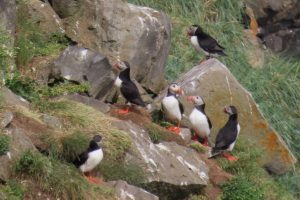
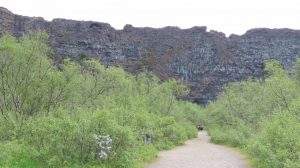

On to Vatnajökulsþjóðgarður National Park –Ásbyrgi–we went, where we observed a barrow’s goldeneye displaying in a pond, literally kicking up his heels. Red-necked phalaropes and a Eurasian wren also gave us close-up views. We ended in Kópasker, on the edge of the ocean, with black sand beaches.
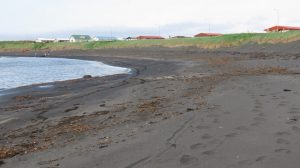
Finally, we headed off to the Sel Hótel Mývatn for an elegant dinner, buffet or a la carte. Near the hotel a gyrfalcon perched on a rock right beside the road. I took two shots through the UV-darkened van window before a white wagtail dive-bombed the gyrfalcon and both flew off. What a startlingly sublime gift from the universe! Since we were arriving back at the Lamb Inn late, we hoped to see a short-eared owl but did not.
It was never dark while we were in Iceland, except for one five-mile tunnel, so I don’t know how the birds and other critters know when to eat or sleep. Even when the sun sets at midnight and rises at 2am, it’s twilight but not dark, which can be disconcerting. In winter the sun rises around 11am and sets around 4pm. However, due to the darkness, one can observe the northern lights during the winter months. Even if the northern lights were visible in the summer, one couldn’t see them due to the endless light.


We departed from the Lamb Inn around 9am, admired some long-tailed ducks in the lake, then drove east to F35 south. The rest of the day we were “off road” on gravel with wide views of glaciers, tundra, geothermal wonders, and lava. We stopped at Hveravellir for lunch and a beautiful view of snow buntings, but we did not soak in the adjacent geothermal fumaroles . A boardwalk led us past burbling, steaming water and baby geysers. Hveravellir is an active volcanic area in the highlands of Iceland. As we continued south, we viewed two giant glaciers, Hofsjökull and Langjökull.

Distinguishing clouds from snow can be challenging. The landscapes are vast, desolate, and uninhabited.

Our last stop of the day was Gullfoss, a world-famous falls in the Hvítá river canyon. Hundreds of tourists trudge either to an overlook or beside the falls. Susan and I opted for the closer view where mist drenches humans and our equipment. The roar of the voluminous water is deafening at times, but the majesty is spectacular. Click here to learn about Sigridur Tomasdottir, a female environmentalist who helped make Gullfoss a nature reserve instead of a hydroelectric plant. Sometimes one person CAN make a difference.
We reached the Stracta Hotel in Hella in south Iceland in time for an abundant buffet dinner. This was our home for the last three nights of our tour. The Hella volcano was across the street, dormant but expected to erupt any day. It was long overdue, given its past eruptions schedules.
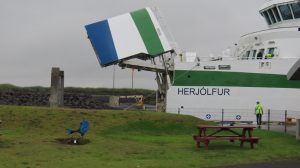 The next morning, after a bounteous breakfast buffet, we departed early for a ferry ride to Westman Islands to search for more puffins. This was also Sandy’s birthday, so I did a French braid in her hair and gave her my Sirius chocolate mint candy bar. The weather was cold and drizzly as we boarded the gigantic Herjólfur Ferry. Its hull opens to allow vehicles to be driven inside and parked. The ferry is electric and very plush with a coffee bar, restaurant and numerous bathrooms (or water closets, as much of Europe says). Comfortable seats and bunk beds are inside the ferry, along with giant windows. In better weather one can stand outside and watch Iceland recede and the Westman Islands appear. Seabirds glide by and bob on the waves.
The next morning, after a bounteous breakfast buffet, we departed early for a ferry ride to Westman Islands to search for more puffins. This was also Sandy’s birthday, so I did a French braid in her hair and gave her my Sirius chocolate mint candy bar. The weather was cold and drizzly as we boarded the gigantic Herjólfur Ferry. Its hull opens to allow vehicles to be driven inside and parked. The ferry is electric and very plush with a coffee bar, restaurant and numerous bathrooms (or water closets, as much of Europe says). Comfortable seats and bunk beds are inside the ferry, along with giant windows. In better weather one can stand outside and watch Iceland recede and the Westman Islands appear. Seabirds glide by and bob on the waves.
Daniel drove the van out of the ferry’s belly and we climbed onboard. First stop: Puffin Point. Puffins tend to hang around there in the morning and late in the afternoon. Mid-afternoon they fly out to sea to cool off and feed, so plan your visit to the point accordingly. We spent two hours there with puffins, nesting black guillemots, a meadow pipit and sheep grazing on the hillside.


 Taking a bad photo of a puffin is difficult; they are so photogenic and cooperative. Several of us have hundreds of photos and are reluctant to delete any of them. The puffin population has declined 70% in the past thirty years. Despite the recent
Taking a bad photo of a puffin is difficult; they are so photogenic and cooperative. Several of us have hundreds of photos and are reluctant to delete any of them. The puffin population has declined 70% in the past thirty years. Despite the recent
Smithsonian Magazine article about locals helping baby puffins find the sea, some Westman Island residents hunt them for food in a nod to traditional customs. Some encourage foreign tourists to have a traditional Icelandic experience by eating puffins. That plus climate change have drastically impacted the puffin population. Enjoy them while you still can, folks. And support conservation organizations that help preserve populations.
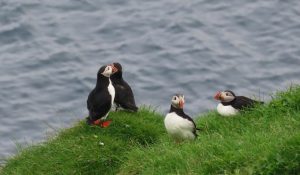




Leaving the puffins, we meandered to a spot on Heimaey where thousands of fulmars and other birds were in a frenzy, feeding on chum from the adjacent fish processing facility. We observed a multitude of seabirds there until lunchtime. Clouds rolled in during the afternoon and most puffins had left Puffin Point when we returned on our way back to the ferry. But we got to observe a few fly in and out from the ocean to their nesting sites in the cliff and disappear into burrows surrounded by rocks, sheep and bright green grass. Wildflowers were abundant as well. A quick tour of a tiny medical museum, church and memorial for sailors lost at sea completed our tour of the Westman Islands. We returned to the ferry and the Stracta Hotel for dinner.

Our last full day of the tour, Mark and I declined to get on the van. We were weary of driving places and decided to walk to local spots, eat lunch outdoors, use the saunas/hot tubs at the hotel, and not be in a vehicle at all for one day. It was the solstice after all. We walked to the river about 1/4 mile from the hotel and saw twenty or so common Icelandic birds. Wildflowers lined the river and the day was sunny and warm.
Iceland weather was unseasonably warm and sunny for most of the two weeks we were there. We had brought wool, rain gear, down puffy coats and other items to keep us warm. We found ourselves wishing for short-sleeved shirts and shorts much of the time. We might have needed the warm and rain gear, but I suppose we lucked out. After the tour ended, Mark and John encountered fog, rain, and cold. So they experienced all the various conditions that Iceland offers in the summer. Shortly after they left Iceland, 5″ of snow fell near where they stayed by Vik. And the following week a volcano on the Reykjanes Peninsula erupted. Be prepared for anything; layers of clothing are essential.

We ate lunch locally and then soaked in the outdoor hot tub. After a few more afternoon walks, our group returned. Mark and I had pre-dinner, a sourdough crust pizza from a food truck, Lava ’47. “The Hawk” was what we ordered, and it was scrumptious. Later we joined our group for our last buffet dinner at the Stracta.
Our final day, we loaded all of our luggage into the van. We drove in a misty rain to the Reykjanes Peninsula and the Garðskagaviti Lighthouse built in 1897. “Something smells fishy” is a well-known saying, perhaps originating at this spot. The fishy smell was overpowering, but we saw lots of seabirds before heading to lunch in Keflavik. After lunch the sun appeared, and Daniel gathered us by an old boat for a group photo to commemorate our tour.

Then off to the airport eight of us headed, leaving Mark, John, Susan, Paul and Dave behind.
To give an idea of where we toured in Iceland, here is a map with points marked:
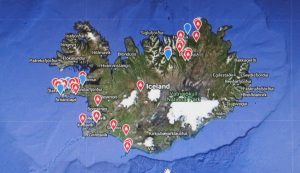
My trip home was fraught with thunderstorms, delays, downgrades, tornadoes and other obstacles. Seeing the city lights of Albuquerque at 11pm was a bit disorienting after two weeks without darkness. But I adjusted and made it home before midnight (6am Iceland time), petted the little dog, showered and went to bed. Thanks to Daniel, Dave, Mark, Susan, Paul, John, Sandy, Chicago Tim, Candice, Denver Tim, Daphne, Brenda and Peter for a sensational Iceland adventure!

— Finis —
(c) 2023, Merri Rudd, All Rights Reserved
I always thoroughly enjoy reading Merri’s writing! It flows so effortlessly in equal parts detail and enthusiasm. Her photos are equally as beautiful. I felt transported to Iceland as I enjoyed this blog. It was enchanting to see the stark, yet, elegant countryside along with the birds. Looking forward to the next adventure!
Great photos and descriptions. I think I would have done what you and Mark did the last day since it sounds like a lot of driving!
Merri,
The breathtaking photos just confirm what I imagine it would be like to visit Iceland. The blues are so blue; the greens are so green, and the puffin beaks are so orange! I just love how you weave your bird sightings into the stories of your daily tours. How marvelously unique your birding vacations are! How marvelous to have old and new friends to share these adventures with!
Merri,
You are quite the journalist and photographer!
What a delightful recount – I felt as if I were there.
What a stunning account! I had no idea Iceland had so much beauty to offer, & the plea to reconsider the traditional treatment of Puffins was very sad and poignant. Loved the pictures – nature enthusiasts take the best wildlife & landscapes! I zoomed most of them to my monitor size to see more detail, but it was great to have them right in there with the relevant text. There are so many destination & gear links, it’s tempting to organize a repeat of the trip. Looked like a once-in-a-lifetime privilege & fabulous tour. It’s so great that you & Mark got to do it. Thanks for sharing it so completely.